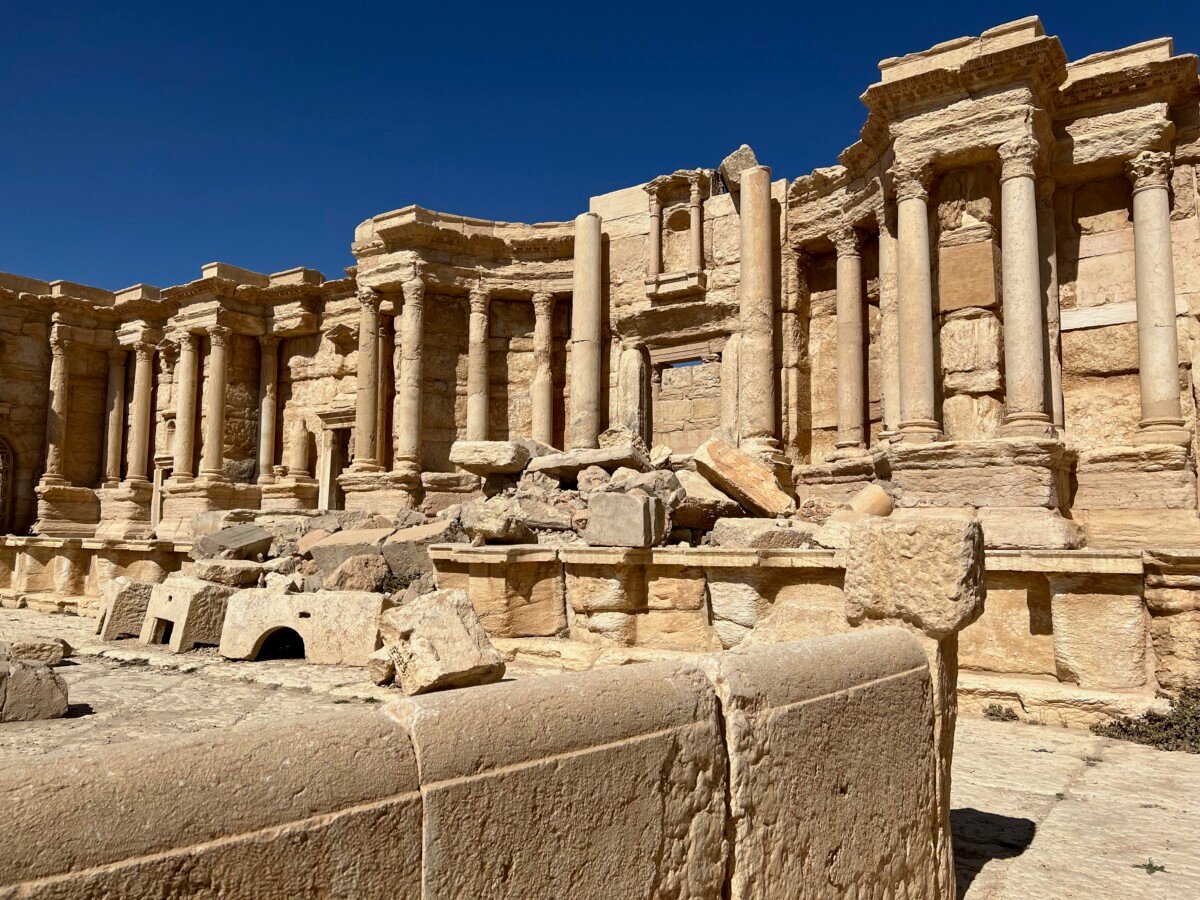Nestled in the heart of the Syrian desert, the ancient city of Palmyra stands as a testament to the grandeur and diversity of human civilizations that once thrived in this region. Known as the “Pearl of the Syrian desert,” this oasis city was a beautiful bridge between the East and West. It was a city at the crossroads of civilizations, a city that grew from a humble village into a grand metropolis of the ancient world.
Visit Palmyra with a CultureRoad Syria trip – how about our next group tour, or let us customise a private Syria tour just for you.
The Early Beginnings

The first recorded mentions of Palmyra, or Tadmor as it was originally known, date back to the time of Sargon the Great (c. 2334–2279 BC) of Assyria. It was a small village located by the Eqfa Spring in modern-day Syria. The fertile soil, abundant palm trees, and springs made it an ideal location for farming and herding. As the settlement grew under the Seleucid Empire (312–63 BC), its strategic position—halfway between the Mediterranean Sea and the Euphrates River—began to be recognized.
The Rise of a Caravan City

Palmyra’s transformation from a village into an important city happened under the Seleucids, but it was the Roman annexation in 64 BC that catapulted it into one of the major cultural and trade centers of the world. Renamed Palmyra, meaning “place of palm trees,” the city thrived under the Romans, especially after the annexation of Nabatea in 106 AD. Given the rank of a “free city” in 129 AD and becoming a Roman colony in 212, Palmyra replaced Petra as the premier trading center in the Near East.
The Heart of Trade Routes
Palmyra’s location was a crucial factor in its rise to prominence. It lay perfectly on two of the most important trade routes in the ancient world: one extending from the Far East and India to the head of the Persian Gulf, and the other, the Silk Road, stretching across the Eurasian continent to China. The city saved traders from having to navigate around the vast Syrian desert, considerably reducing transportation times. The Romans, with their increasing demand for oriental luxuries, patronized Palmyra heavily, establishing it as a major trading city.
A Cultural Melting Pot

The city, known as the “bride of the desert,” became a hub for the exchange of goods, ideas, and cultures. From Rome to China, and from the Parthian Empire to India, goods and people flowed through Palmyra. It was a city where one could find precious stones, silk, spices, and much more. As a rich, thriving metropolis, it was a meeting point for a number of civilizations, a fact that is most clearly reflected in the city’s unique architecture.
The Architectural Marvels
The architecture of Palmyra Syria testifies to its status as a major cultural center. Buildings fused Graeco-Roman techniques with Persian, Aramean, and Arab influences, creating a unique blend that stood as a testament to the city’s rich heritage. The city was organized around a grand, colonnaded street measuring 1100 meters, with secondary streets linking major public monuments. Among the most notable structures were the Temple of Bel and the Temple of Baalshamin, which displayed a synthesis of Roman and Eastern architectural styles.
Sadly, these architectural marvels were extensively damaged by the extremist group ISIS in 2015 and 2017, robbing the world of some of its most unique historical artifacts.
The Cultural Diversity

The cultural diversity of Palmyra extended beyond its architecture. Even the attire of the Palmyrenes, although oriental in form, was adorned with Greek ornamental motifs, a testament to the blending of cultures that took place in this city. The city stood as a testament to the exchange and fusion of diverse peoples and civilizations. This, coupled with Roman patronage, made Palmyra one of the wealthiest cities of the ancient world and a jewel of the Near East.
A City of Empires and a Queen
However, this prosperity lasted only until the early 2nd century, when the Sassanian empire disrupted trade routes in the region. Between 224 and 267, the Romans and the Sassanians wrestled for control over the region. In the midst of this turmoil, the Arab queen, Zenobia, declared Palmyra’s secession from Rome in 267 AD. After taking over rule from her husband, she established the Palmyrene Empire, with Palmyra as the capital. This vast empire stretched from Egypt to much of Asia Minor. However, this was short-lived as the city was reconquered by the Roman emperor Aurelian in 272 AD, and in the process, the city was destroyed.
The Changing Hands and Decline

After the fall of Zenobia, Palmyra continued under Roman and then Byzantine rule, becoming a Christian city. In the 6th century, it came under the control of various Islamic caliphates, starting with the Rashidun Caliphate in 634 AD. The city, however, was on a path of decline and never regained its former glory. It was eventually destroyed by the Timurids in the early 14th century.
Today, what was once one of the greatest centers of the world, is a relic of a world long lost to history. The city returned to its humble beginnings, devolving into a small Syrian village. The ruins of Palmyra stand as a testament to the grandeur of human civilizations, a reminder of an oasis city that was once a beautiful bridge between the East and West. As you ponder over the ruins in a Syrian desert, be reminded of the city’s glorious past, the cultures it hosted, and the important role it played in the annals of human history.
